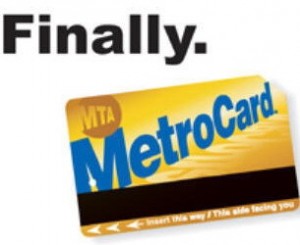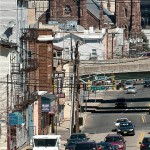New Jersey Future Blog
How about an E-ZPass for transit?
August 12th, 2011 by Elaine Clisham
A comment in response to our blog post last week about how five of the top 10 public-transit cities in the country are in New Jersey, got us thinking. The comment said:
While Hudson County on paper looks good, in actuality it’s not all that convenient. You have three/four systems working independently and charging separately for their services. Transfers are tedious, time-consuming and expensive. A comprehensive, pedestrian-friendly, fare-sharing system needs to be implemented in the nation’s 6th most densely populated county.
The part about independent operations is important: For transit to be a truly viable commuting option it must offer coordinated access across modes. As obvious as this seems, some cities have been surprisingly slow to put it in place. New York’s MetroCard and Boston’s CharlieCard are both usable on subways and buses but only the pay-per-ride MetroCard can be used on PATH trains. Washington, D.C.’s Metro system only finished outfitting all its buses with SmarTrip card readers in 2004, and in October 2010 was still in the process of enabling SmarTrip users to load multi-trip regional bus discount passes. So we’re getting there, but obviously have more to do.
Now let’s take this idea one step further: What if a traveler could use the same farecard on any city’s transit system? We know this is possible because some travelers have been using the technology for years. They call it E-ZPass. E-ZPass allows a driver to travel from Maine to Virginia (and perhaps other places) using one transponder linked to one account, regardless of the state or the individual road’s fare structure. Similarly, an E-ZPass for transit would allow a traveler access, regardless of fare structure, to Boston’s T, New York’s MTA, Chicago’s Metra, Baltimore’s subway and light rail, Washington’s Metro, and Philadelphia’s … well, we hear their computerized fare system is coming soon.
Will this increase transit use? It might. For places where transit modes are not already coordinated, such as Hudson County, one-card access would almost certainly force better coordination of modes and fares, which, if the commenter above is correct, would indeed lower a barrier to local transit use. And such inter-operability may also increase transit use among visitors to a city. Rather than going through the hassle of understanding a new fare payment structure (some of which don’t allow you to purchase the exact amount of a trip), a New York resident who visits Boston, for example, could simply use a MetroCard for access to the T. The correct fare would be deducted automatically.
Washington’s Metro and the Maryland Transit Authority have taken a good first step in this direction, allowing SmarTrip cards and CharmCards to be used interchangeably on any of either system’s participating transit providers. But our historic prioritization of automobile travel over transit has meant that drivers are well ahead of transit riders in digital access across systems. We look forward to transit catching up soon.


















We were in New York City this weekend and I needed to travel back to Newark early on Saturday morning. My friend was explaining the trip to me and I had to choose between a few options. The thought of having to buy a NJ Transit ticket instead of just using my MTA card influenced my ultimate decision to transfer to PATH in the financial district and avoid the ticket machines completely.
Though I have to admit, I am one of the very late adopters with EZ Pass. There is definitely something I don’t like about a device tracking my travel patterns, though ironically, I use Foursquare. After waiting in tunnel traffic last weekend, I swore I would never drive into the city without it again.
Yeah, I didn’t even try to consider linking transit passes with regional rail. Given the fare differences, you would need the ability to swipe a card at the beginning and end of a trip, which means that apart from the technological challenges, you would have to alter commuter traffic flow significantly in order to avoid massive exit congestion.
Washington, D.C., makes you swipe on exit (as does Paris), but the traffic is sufficiently spread out across the system that delays are minimal at any one station (and, frankly, the many escalator malfunctions serve as a very effective traffic regulator at the exits!). Just imagining the backup at an exit turnstile in Penn Station … yikes!
San Francisco’s Clipper Card can be used on buses, trams, 2 different subways, and regional rail. The only drawback is that, like DC’s SmarTrip or PATH’s SmartLink cards, you have to buy Clipper at a transit services office or a retail outlet instead of at any station vending machine.
Internationally, Paris, Sydney, and Melbourne also have fare card systems that work on both inner city bus/subway/tram/ferry transit and regional rail. I would venture to guess that London and Hong Kong have this as well.
Additional data point: I have recently had the opportunity to visit both Boston and Chicago, and to ride their subway systems. Both sell basic fare passes in $5, $10 and $20 denominations, even though one round trip costs $4 in Boston and $4.50 in Chicago. (Do the math to figure out how many round trips would leave you with no leftover balance on your fare pass; it would take me 20 years to use up nine round-trips in Chicago.) Transit was still the better option in both cases, but really, guys, you need the extra $1 or $0.50 that badly? Just let me use my SmarTrip card already.
Both London (Oyster Card) and Amsterdam (OV Chip-card) allow for transfer for between all modes: tram, rail, metro by passing (not swiping) encoded card in front of conveinently placed “readers.” This allows for pro-rated pricing, smooth transfers, and true regional mobility not hindered by 17th-century borders and 20th-century technology. Only when MTA/NJT/PANYNJ look at travellers’ needs and patterns and just not protection of their own interests will there be any effort to remove unnecessary inconveniences.